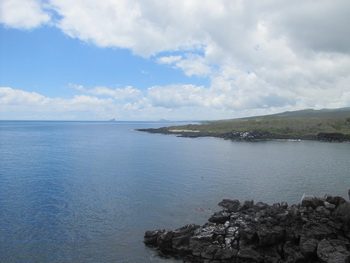
Galapagos Islands
San Cristobal
April 2010
Part Two
| |
| HOME |
| About Tenaya |
| About Us |
| Latest Update |
| Logs from Current Year |
| Logs from Previous Years |
| Katie's View |
| Route Map |
| Links |
| Contact Us |
![]()
April 17, 2010
Originally called the Enchanted Islands and now officially known as the Archipielago de Colon, most of us know these volcanic islands as the Galapagos Islands.

Sandy, lava-strewn beach on Isla San Cristobal
The archipelago lies in an exceptional location on the planet, at the crossroads of one warm (Panama) and two cold (Humbolt and Cromwell) ocean currents with prevailing wind systems blowing from the east from both hemispheres. San Cristobal, the eastern most of the 19 islands, is about 600 miles from mainland Ecuador. The other islands stretch 174 miles to the west. There are also 42 islets or surfacing rocks and another 26 emerging rocks.

The islands are purely oceanic, they have never been connected to the mainland in any way. Endemic creatures are either sea mammals, reptiles, birds, insects or plants. Some reached the islands via water currents carrying them on natural rafts. Others, such as seeds and birds, were carried with the wind. These pioneer species had to find a place to live, a mate and to raise their young. Very few succeeded.

During his journey with Fitzroy on the Beagle to chart the Pacific waters, Darwin arrived at the Galapagos in 1835 and spent five weeks in the archipelago. The diversity of the finches aroused his interest. He found 13 different species with various shaped beaks and different feeding habits. In 1845, long after his journey, he published his theory that a mother species had modified to different ends for specific functions. His theory of evolution by natural selction is the basis of the understanding of the origin of species

The different beaks of Darwin's finches
We arrived at the eastern most island, San Cristobal, and anchored in Wreck Bay after our 9 day passage from Panama. All arriving yachts must work with an agent and we had contacted Bolivar three months earlier. An hour after the anchor was set Bolivar arrived by water taxi accompanied by the port captain and immigration officer. Checking in was an easy affair in our cockpit.
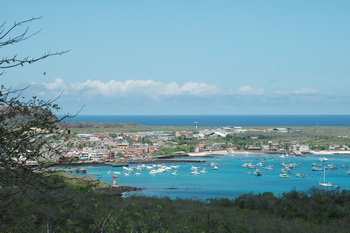
Wreck Bay and Puerto Baquerizo Moreno
Bolivar obtained for us an autografo which allows us to anchor at Santa Cruz and Isabela islands and stay in the archipelago for 60 days. Without it we would only be allowed to stay at one anchorage, either Wreck Bay or Puerto Ayora on Santa Cruz, for 20 days.

Wreck Bay Anchorage, San Cristobal, Galapagos
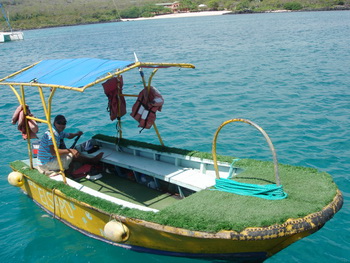
Water taxis take yachties to shore and back
What a wonderful anchorage! Inquisitive sea lions frolic around the boats and frigatebirds soar overhead while pelicans skim the surface of the water and dive from high above.
The small town of Puerto Baquerizo Moreno is quite pleasant. The people are friendly and it is not overrun with tourists. A lovely promenade spans the length of town along the waterfront. It is a favorite place for sea lions to gather while yachties gather in the comfortable restaurants and bars.

A promenade runs the length of town
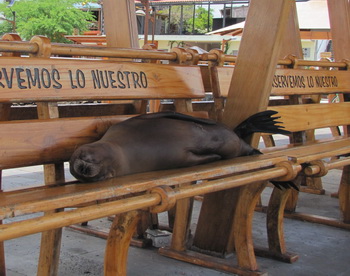
Sea Lions are everywhere along the waterfront
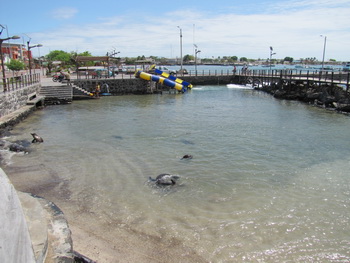
A natural pool for children to swim with sea lions
A marvelous interpretive center is located at the northwestern end of town that explains the natural and human history of the island. From there it is possible to follow wooden and stone paths over lava rocks and past cacti and scrubby vegetation to several scenic vistas, a snorkeling bay and a lovely sand beach.

One of the paths from the interpretive center
One day we joined J. P and Ann-Katrin from s/y Kali for a taxi ride to several sites around the island. We visited La Loberia, a nearby beach strewn with volcanic rubble and home to many marine iguanas and sea lions.

Sea Lions at La Loberia

Marine Iguanas at La Loberia
Our tour took us to a volcano where we were pleasantly chilled in the misty gray gloom at an elevation of 700 meters. The island's only freshwater lake, El Junco, sits in the caldera. A nice path circles the rim.
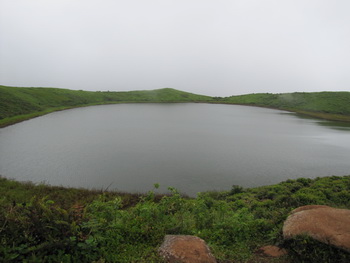
El Junco
We visited La Galapaguera de Cerro Colorado, a tortoise reserve with a raised track winding through the shrubs with several feeding areas populated by the large creatures. Galapagos tortoises are bred here and released to the wild at five years of age. Cages protect the young tortoises from introduced predators. A interpretive center explains their history and their plight.
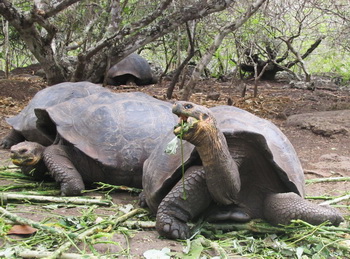
Galapagos tortoises at La Galapaguera

Fauna at sea level
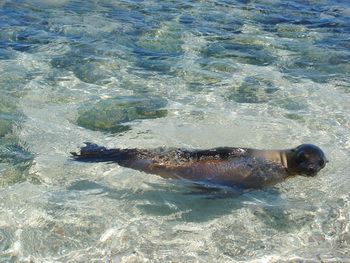
Sea lions play at La Loberia
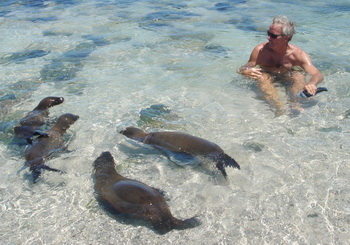
Sea lions and pups come to meet Jim

A sea lion joins Katie on the beach
J. P. and Ann-Katrin signed up for a snorkeling trip to Leon Dormido, also known as Kicker Rock. It sounded fun so Mike signed up to snorkel and Jim and I decided to dive. We knew something was up when we were given 5 mil full-suits. Just because we are on the equator doesn't mean the water is warm! Funny currents here...
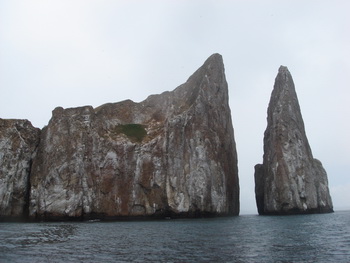
Leon Dormido or Kicker Rock
Our first stop was at Isla Lobos, an island just offshore with shallow water filled with fish, several sea lions and some marine iguanas. It was a perfect spot for snorkeling and dive checks. Marine iguanas swam along the black lava rocks and we spotted one completely underwater holding onto a submerged rock covered in marine algae. He was chomping away at the algae and not bothered in the least as a yellowtail damselfish repeatedly darted at its face. Onshore a male frigatebird hoped to attract a mate with his red chest puffed up admirably.

Katie and Jim on the dive boat with Kicker Rock in the background
On our first dive we saw several Galapagos Sharks and the second dive we saw them again along with a few Scalloped Hammerhead Sharks and one Black Tip Reef Shark. Yikes! That was a little scary. When the divemaster clung to the rocks and didn't move we did the same. We also saw several large green turtles. One was eating something that resembled a liter-sized plastic bottle about two meters from us. Seeing sharks was a new experience. We are happy to have done it and now never have to do it again!

Scalloped Hammerhead Sharks. No, we didn't take this photo.
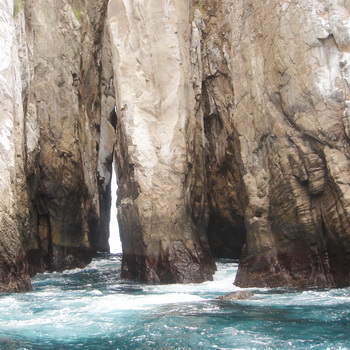
There was a lot of surge around the base of Kicker Rock
We went with Wreck Bay Diving Center and had a great time. Their equipment was top-notch with high quality, well-fitting wetsuits. Angel, Ivan and the captain were fun, knowledgeable and took good care of us. They fed us treats and drinks between dives and afterwards put out the fixings for a delicious lunch at a scenic sandy beach.

Angel and the owner (we think) of Wreck Bay Diving Center
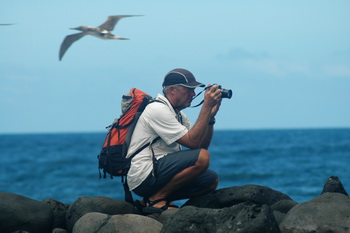
Jim photographing iguanas as a booby flies by

This shack near the beach serves yummy burgers
We have enjoyed our time here on San Cristobal and could spend longer but since we have a schedule and want to see the other islands we will leave tomorrow for Santa Cruz.
Recommended reading:
Galapagos, A Natural History Guide, Pierre Constant.
This Thing of Darkness, Harry Thompson. A historical novel about the voyage of the Beagle and all Fitzroy and Darwin faced at land, on sea, and conflicts of their religious loyalties and scientific minds. By the way, Darwin was seasick his entire voyage!
Go to Galapagos Part Two - Santa Cruz
.